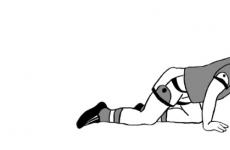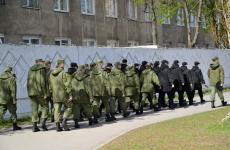Industrial water turbines and windmills. What is a new wind turbine and what type is it? Wind generator with different power
The issue of wind energy in our innovative time is of interest to many. Those who have ever visited European countries in their car have probably seen huge wind farms.
Hundreds of generators are encountered along the way.
Observing such a picture, many begin to believe that obtaining electricity with the help of wind is a very promising and profitable occupation. Wise Europeans cannot be wrong.
At the same time, for some reason, the fact is ignored that in other places of the same Europe, there are practically no such wind farms. Why did it happen?
That's it about this, when, where and how it is profitable to use windmills, and when not, and will be discussed in the article.
autonomy
 Surely, after the next rise in the price of electricity, you thought about installing a wind generator on your site. Thus, providing, if not all, then most of their needs for electricity.
Surely, after the next rise in the price of electricity, you thought about installing a wind generator on your site. Thus, providing, if not all, then most of their needs for electricity.
Some are even considering becoming independent from the grid this way. How realistic and possible is this? Unfortunately, for 90% of owners of private houses, these dreams will remain dreams.
And so that you do not waste your money, we will tell you with the calculation of all the numbers why this is so.
Wind speed
Unfortunately, there are not many regions in our country where the wind speed is at least at the level of 5-7 meters per second. The data is taken on an annual average. In the vast majority of latitudes suitable for habitation, this very speed is equal to a maximum of 2-4 m / s. 
This suggests that your wind turbine most of the time, simply will not work. For stable electricity generation, it needs a wind of about 10 m/s. 
If the wind in your area is 7m/s, then the generator will operate at a maximum of 50% of its nominal value. And if only 2 m / s, then by 5%.
In fact, in an hour, a 2kW generator will give you no more than 100W.
You will also encounter another wind problem that manufacturers are silent about. Near the ground, its speed is much less than at the top, where industrial installations 25-30m high are placed. 
You will mount your unit at a maximum of ten meters. Therefore, do not even be guided by wind tables from different sites. This information does not apply to you.
Manufacturers are modestly silent that for their wind resource maps, measurements are made at a height of 50 to 70 meters! In addition, data on turbulence and eddies are not taken into account there. 
If you try to lift it higher than 10m, you will definitely think about lightning protection. Blades electrified by air friction, very tasty bait for discharges! 
In addition, for some reason, everyone is only worried about such a parameter as wind speed, and at the same time they forget about its density or pressure. And the difference for energy is very significant. The dependence of electricity generation on wind pressure is disproportionate.
So, if the wind pressure doubles, the generated power increases eight times!

In addition, there is a certain craftiness in the indicated technical specifications generators.
Of course, you can trust them, but only for ideal conditions. Because:

- and in laminar flow with a constant direction and increased density
You have on suburban area the wind speed can be such that it will not work to turn the shaft, let alone generate energy. 
And this is spring or autumn. It is during this period that the most active movements of air masses occur. 
Do not forget that the windmill does not operate in the idling mode of the turntable, but must spin the generator rotor surrounded by neodymium magnets. 
And this is only as long as the electric potential of the windmill is lower than the battery voltage. When the voltage is sufficient to start charging, the battery turns into a load. 
If low-speed structures with a vertical axis of rotation are used, then there is already a step-up gearbox. Have you tried spinning the booster? Such a design becomes more complicated, weight, windage, cost increase. 
Even at the lighthouses of the Northern Fleet, given the constant winds and the polar night there, experts prefer to use solar panels. When asked why this is so, they answer in a simple way - there are fewer problems!
Wind turbine batteries
Large industrial wind turbines can transfer energy directly to the grid, bypassing any batteries. 
But you can't do without them. Without a battery, neither the TV nor the refrigerator will work. Even the lighting will shine in fits and starts, depending on the gusts of wind. 
At the same time, for 12-15 years of operation of the generator, you will be required to change 3-4 sets of batteries, thereby doubling your initial costs. Moreover, we take an almost ideal option, when the batteries will be discharged no more than half of their capacity. 
Of course, you can buy cheap battery models, but the costs will not decrease from this. Just going to the store for new batteries will not be done 4 times, but already 8.
Where is the best place to install
Another thing to seriously think about is the availability of free space. Moreover, in terms of area, it can go 100 or more meters in each direction from the mast. 
The wind should move freely along the blades, and reach them without interference from all sides. It turns out that you must live either in the steppe or near the sea (preferably directly on its shore).
The ideal location would be at the top of the hill. Where from the position of aerodynamics, the air flow is compacted with a corresponding increase in wind speed and pressure. 
Forget about neighbors. Their gardens and two-three-story mansions will “drink your blood” great, blocking the tailwind every time. As well as neighboring forest plantations. 
The same industrial windmills are not placed directly one behind the other, but mounted diagonally. Each subsequent one should not close the previous one. 
Price for 1 kW of power
The 4th reason is the high price. Do not be fooled by the prices of sellers in price lists. They never show real value all necessary equipment.
Therefore, always multiply prices by 2, even when choosing the so-called ready-made kits. 
But that's not all. Do not forget about operating costs, reaching up to 70% of the cost of windmills. Try repairing the generator at a height, or dismantling and disassembling and assembling the mast each time. 
Don't forget to replace the battery periodically. Therefore, do not expect that a windmill can cost you $ 1 per 1 kW of electricity.
When you calculate all the real costs, it turns out that each kilowatt of power of such a wind generator cost you at least 5 bucks.
Payback period and savings calculation
 The fifth reason is inextricably linked with the first four. This is the payback period.
The fifth reason is inextricably linked with the first four. This is the payback period.
For your individual wind turbine, this period is NEVER.
The cost of a windmill, mast and additional equipment for 2-kilowatt high-quality models will reach an average of 200 thousand rubles. The performance of such installations is from 100 to 200 kW per month, no more. And this is under good weather conditions. 
Even precipitation reduces the power of windmills. Rain by 20%, snow by 30%.
So it turns out all your savings - this is 500 rubles. For 12 months of continuous work, a little more will come in - 6 thousand.
But if you remember the initial spending of 200 thousand, then you will return them in thirty-two years!
And all this without taking into account operating costs. And if you estimate that the average life of a good windmill is about 20 years, it turns out that it will finally and irrevocably break down even before it reaches payback. 
At the same time, a 2-kilowatt unit will not cover 100% of your needs. A maximum of a third! If you want to completely connect everything from it, then take a 10-kilowatt model, no less. The payback period will not change. 
But there will already be completely different dimensions and weight. 
And fixing it just like that on a pipe through the attic of your roof will definitely not work. 
However, some are still convinced that due to the endless rise in the price of electricity, the wind generator will at one fine moment, in any case, become profitable.
When to buy a wind turbine
 Of course, electricity is getting more expensive every year. For example, 10 years ago, its price was 70% lower. Let's carry out approximate calculations and find out the prospect of a windmill paying off, taking into account the sharp rise in the cost of electricity.
Of course, electricity is getting more expensive every year. For example, 10 years ago, its price was 70% lower. Let's carry out approximate calculations and find out the prospect of a windmill paying off, taking into account the sharp rise in the cost of electricity.
We will consider a generator with a power of 2 kW. 
As we found out earlier, the cost of such a model is about 200 thousand. But taking into account all the additional costs, you need to multiply it by two. It will turn out at least 400 thousand rubles. costs, with a service life of twenty years.
That is, for a year it turns out 20 thousand. At the same time, in fact, this year the unit will give you a maximum of 900 kW. Because of the coefficient installed capacity (it does not exceed five percent for small windmills), you will wind up 75 kW per month. 
Even if we take 1000 kW per year for ease of calculation, the cost of 1 kW / h received from a windmill will be 20 rubles for you. If we assume that electricity from thermal power plants will rise in price by 4 times, then this will not happen tomorrow, and not even in 5 years. 
Which windmills to choose
Well, for those who live far from substations and VL-0.4kv, it is worth purchasing the most powerful windmill models that you can afford. Since from the power that is indicated in the pictures, you will get no more than 15%.
Another category of consumers, quite deservedly, makes a choice not in favor of Chinese factory models, but, on the contrary, prefers home-made windmills from self-taught masters. It also has its benefits. 
For the most part, the inventors of such devices are competent and responsible guys. And in almost 100% of cases, without any problems, they can return the installation if something went wrong, or it needs to be repaired. This will definitely not be a problem. 
At industrial Chinese windmills, appearance certainly prettier. And if you still decide to buy it, immediately after checking it with an electric drill, do preventive maintenance and replace Chinese scrap metal with bearings with high-quality grease. 
If there are large bird nests near you, it does not hurt to purchase an additional set of blades.
Chicks sometimes fall under the distribution of a spinning "mini mill". Plastic blades break and metal ones bend. 
And I would like to finish with wisdom from those users who did not listen to all the arguments and came across all the problems described above. Remember, the most expensive weather vane for a home is a wind turbine!
Wind power is actively developing all over the world, and it has long been no secret to anyone that this is one of the most promising areas. alternative energy on this moment. By mid-2014, the total capacity of all installed wind turbines in the world was 336 gigawatts, and the largest and most powerful vertical three-bladed wind turbine Vestas-164 was installed and launched in early 2014 in Denmark. Its power reaches 8 megawatts, and the span of the blades is 164 meters.
Despite the long-running technology for manufacturing bladed turbines and windmills in general, many enthusiasts are striving to improve the technology, increase its efficiency and reduce negative factors.
As is known, the wind flow energy utilization factor y in best case reaches 30%, they are quite noisy and disrupt the natural heat balance of nearby areas, raising the temperature of the surface air layer at night. They are also very dangerous for birds and occupy large areas.
What alternatives exist? In fact, the creativity of modern inventors knows no bounds, and many different alternatives have been invented.
Let's take a look at 5 of the industry's most unusual alternative designs wind generators.
Since 2010, the American company Altaeros Energies, based at the Massachusetts Research Institute, has been developing a new generation of wind turbines. A new type of wind turbine is designed to operate at altitudes up to 600 meters, where conventional wind turbines simply cannot reach. It is at such high altitudes that the strongest winds constantly blow, which are 5-8 times stronger than winds near the surface of the earth.

The generator is an inflatable structure, similar to a helium-filled airship, in which a three-blade turbine is installed on a horizontal axis. Such a wind generator was launched in 2014 in Alaska to a height of about 300 meters for testing for 18 months.

The developers claim that this technology will provide electricity at a cost of 18 cents per kilowatt-hour, which is half the cost of wind power in Alaska. In the future, such generators may well replace diesel power plants, as well as find application in problem areas.
In the future, this device will be not just a generator of electricity, but also part of a weather station and a convenient means of providing the Internet in areas far from the corresponding infrastructure.
After installation, such a system does not require the presence of personnel, does not occupy a large area, and is almost silent. It can be controlled remotely, and requires Maintenance only once every 1-1.5 years.

Another interesting solution to create an unusual wind farm design is being implemented in the United Arab Emirates. Not far from Abu Dhabi, the city of Madsar is being built, in which they plan to build a rather unusual wind farm, called the Windstalk developers.
The founder of the New York design company Atelier DNA, which is developing the design of this project, said that the main idea was to find a kinetic model in nature that could serve to generate electricity, and such a model was found. 1203 carbon fiber stalks, each about 55 meters high, with concrete foundations 20 meters wide, will be installed at a distance of 10 meters between them.
The stems will be reinforced with rubber, and have a width of about 30 cm at the base, and taper up to 5 centimeters. Each such stem will contain alternating layers of electrodes and ceramic discs made from a piezoelectric material that generates an electrical current when subjected to pressure.
As the stems sway in the wind, the disks will compress, generating an electrical current. No wind turbine noise, no bird casualties, nothing but the wind.
The idea arose from observing reeds swaying in a swamp.
Atelier DNA's Windstalk project won second place in the Madsar-sponsored Land Art Generator competition to select the best work of art from international submissions that can generate energy from renewable sources.
The area occupied by this unusual wind farm will cover 2.6 hectares, and in terms of power it will correspond to a conventional wind turbine occupying a similar area. The system is efficient due to the absence of friction losses inherent in traditional mechanical systems.

At the base of each stalk will be a generator that converts torque from the stalk through a system of shock absorbers and cylinders, similar to the Levant Power system developed in Cambridge, Massachusetts.
Since the wind is not constant, an energy storage system will be applied so that the stored energy can be used even when there is no wind, the project staff explains.
At the top of each stem, an LED lantern will be installed, the brightness of which will directly depend on the strength of the wind and the amount of electricity generated at the moment.
Windstalk will run on a chaotic wobble, which allows you to place the elements much closer together than is possible with conventional bladed wind turbines.
A similar Wavestalk project is being developed to convert the energy of ocean currents and waves, where a similar system would be upside down underwater.

The project, developed by Tunisian firm Saphon Energy, is like Windstalk a bladeless wind turbine, but this time the device has a sail-type design.
This silent generator, shaped like a satellite dish, was named Saphonian. It has no rotating parts and is completely safe for birds. The screen of the generator makes forward and backward movements under the influence of the wind, creating vibrations in the hydraulic system.
The goal of the project is to improve the performance of wind generators in relation to the use of the wind flow. The wind is literally harnessed to the sail, which makes forward and backward movements under its action, while there are no blades, no rotor, no gears. This interaction allows you to convert more kinetic energy into mechanical energy using pistons.
Energy can be stored in hydraulic accumulators, or converted into electricity by means of a generator, or it can be used to set some mechanism into rotation. If conventional wind turbines have an efficiency of 30%, then this sail-type generator gives all 80%. Its efficiency exceeds blade-type windmills by 2.3 times.

Due to the absence of expensive components, as is the case in a wind turbine (blades, hubs, gearboxes), in the case of Saphonian, equipment costs are reduced by up to 45%.
The aerodynamic shape of the Saphonian has the advantage that turbulent wind currents have little effect on the body of the sail, and the aerodynamic force is only increased. It is because of turbulence that wind turbines are not used in urban areas, and Saphonian can be used there too. In addition, harmful acoustic and vibrational factors are minimized. Saphon Energy received an award from KPMG for its efforts in innovation.

Another very revolutionary approach to the use of wind energy was implemented back in 2008 by an inventor - an enthusiast from California. Large wind turbines for small towns are 30 storey house, and their blades reach the size of the wings of a Boeing 747.
These giant generators certainly produce a lot of energy, but the production, transportation and installation of such systems is complex and expensive. Despite this, the industry is growing by more than 40 percent every year. That's what Doug Selsum of California was thinking before setting out on his ambitious goal. He decided that it was quite possible to get more energy using fewer materials.
By installing a dozen or several dozen small rotors on one shaft connected to one generator, Doug finally achieved his goal. He connected one end of a long shaft to a generator, and launched the other end into the sky in helium balloons. The system worked as expected.
Doug had read in textbooks that a single-rotor turbine was enough to get the maximum, but Doug had doubts. He thought differently: the more rotors, the more wind energy is available for use.
If each rotor is positioned at the right angle, then each rotor will get its own wind, and this will increase the generation efficiency.
Of course, this complicates the physics, because now we had to make sure that each rotor catches its own flow, and not just the flow from the adjacent rotor. needed to find out optimal angle for the shaft in relation to the wind and the ideal distance between the rotors. And, in the end, the gain was obtained by using less material.

In 2003, the inventor received a $75,000 grant from the California Energy Commission to develop a 3,000-watt seven-rotor turbine. The challenge was successfully met and Doug Selsam has already sold over 20 of his 2000 watt twin rotor turbines to several homeowners. He built these devices in his suburban garage.
Doug's idea was one of the few ideas that actually has every chance of making big headway in the commercial world. Selsam says the two rotors are just the beginning. He will probably see his multi-rotor turbines a mile across the sky someday.

Archimedes, headquartered in Rotterdam, the Netherlands, has come up with its own concept of unusual wind turbines that can be installed directly on the roofs of residential buildings.
As conceived by the authors of the project, an effective low-noise design can fully provide small house electricity, and a complex of such generators, working in conjunction with, is able to completely reduce to zero the dependence of a large building on external sources electricity. The new wind turbines are named Liam F1.
A small turbine, 1.5 meters in diameter and weighing about 100 kilograms, can be installed on any wall or roof of a residential building. Usually, the height of the terraced roofs is 10 meters, and the wind in the country is almost always Southwest. These conditions are sufficient to correctly place the turbine on the roof, and effectively use wind energy.
Two problems of conventional wind turbines are solved here: the noise of conventional bladed turbines and the high cost of installing bulky equipment. In ordinary wind generators installation costs often do not pay off. The noise level of the Liam turbine is about 45dB, which is even quieter than the noise of rain (rain noise in the forest is 50dB).
Shaped like a snail shell, the turbine turns in the wind like a weather vane, capturing the air flow, reducing its speed, and changing direction. Company director Marinus Miremeta claims that the efficiency of the innovative turbine reaches 80% of the maximum efficiency theoretically available in wind energy. And this is already quite enough.
In the Netherlands, the average household consumes 3,300 kWh electrical energy in a year. According to the developers, half of this energy can be provided by one Liam F1 turbine with a wind speed of at least 4.5 m/s.
It is possible to place three such turbines at the vertices of a triangle on the roof of a house, then each of the turbines will be provided with wind and they will not interfere with each other, but, on the contrary, will help each other.
If we are talking about installation in a city where turbulent flows take place, then the manufacturer suggests slightly raising the wind turbines installed on city roofs, mounting them on poles so that the walls of neighboring houses do not interfere with wind flows.
The estimated cost of the new turbine, together with the installation, is 3999 euros. Since the device is larger than one meter, a special license may be required for its use, therefore, in the most extreme case, mini-Liam turbines are also produced by the company, the diameter of which is 0.75 meters.
Manufacturers plan to use their turbines not only to power residential and industrial buildings, but also to power ships.
As you can see, manufacturers of wind turbines have plenty of interesting alternatives.
Wind turbines have been used as a source of electricity for decades. For the first time, people began to exploit such structures when they curbed the power of nature and began to build mills. Today, wind turbines of the third generation are used to generate electricity. Moreover, the structures themselves are acquired in Lately more and more unusual forms.
A modern wind turbine consists of the following elements:
- Anemometer. It is responsible for measuring the wind speed and transmits the relevant information to the wind turbine controller.
- Blades. The wind, falling on these elements, causes them to rotate. As a result, a turbine is driven, which generates electricity.
- Brake. It is supplemented by mechanical, hydraulic and other drives. The braking system in a wind turbine is necessary to stop the rotor in case of critical situations.
- Controller. Responsible for managing the entire installation. It automatically starts the wind turbines and stops them running.
- induction generator. The device generates electricity. It is complemented by a high speed shaft.
- Gondola. It is located at the top of the wind turbine. The gondola body hides most of the installation's structural elements, including the brake and controller.
Depending on the type of construction, the wind turbine can be supplemented with other elements. In particular, modern installations are equipped with a fairing that captures the wind and enhances the power of the latter.
Advantages of turbines

wind turbine modern type has the following advantages over its predecessors:
- Capable of operating in high wind speeds. Turbines of a modern type operate when wind flows exceed critical indicators (25–60 m/s).
- Does not create infrasonic waves. Wind turbines of previous generations had this disadvantage.
- Easy installation. The basis of the design is created during production. Separate elements are installed on site and the gondola is mounted on the mast.
- Application of innovative materials. They not only increase the service life of the installation, but also provide ease of installation.
Wind turbines are mainly mounted along the sea and ocean coast or directly on the water. This approach makes it possible to achieve almost year-round operation of the turbine.

Modern developments
Among the disadvantages that blade installations have are the following:
- they violate the natural thermal balance;
- relatively low efficiency, not exceeding 30%;
- occupy a large area;
- pose a danger to birds.
These shortcomings force developers around the world to look for new technological solutions to generate wind energy. Recent achievements include:
1. Soaring turbine.

Structurally, it resembles a balloon filled with helium. Inside, a turbine with three blades is installed on a horizontal axis. Such a system is currently in operation in Alaska. The soaring turbine is located at a height inaccessible to modern wind turbines. Such a system is able to function almost autonomously (personnel participation is reduced to a minimum).
2. Vertical turbines.

Their blades repeat the arrangement of the fins of fish. Due to this design, the turbines are able to generate a sufficient amount of electricity while being at a close distance from each other. The length of the vertical units is 9 m. For efficient operation of the system, it is necessary to install at least two closely spaced turbines. According to preliminary studies, the new type of plant produces 10 times more electricity in comparison with bladed counterparts, occupying an equal area.
3. Carbonaceous "stems".
Implemented in the UAE new project for generating clean electricity. It involves the installation of 1203 carbon "stems" on a 20-meter base. The height of this structure is 55 m. Each separate element systems are located at a distance of 10 m from each other.
The thickness of an individual stem at the base is 30 m. Inside them are layers consisting of alternating electrodes and a piezoelectric material. Under pressure, the latter generates electricity. Energy arises at the moment when the stems sway in the wind. This system provides the same amount of electricity as other wind turbines occupying the same area.
Something similar was created by Tunisian scientists. Their system differs from the carbon stems used in the UAE in that it has a silent generator on top, resembling a satellite dish.
In Holland, it was proposed to install a small structure on each house, capable of generating electricity under the influence of wind power. This wind generator has a turbine that repeats the shape of a snail shell. She, capturing the flow of the wind, turns around and changes the direction of its movement. The performance of such a wind generator reaches 80% of the theoretical performance that such installations can potentially demonstrate.

IN last years there were developments intended for installation on sailing ships. In general, the number of systems that can replace bladed wind turbines is constantly increasing. Perhaps in the future they will be able to solve all the problems facing wind energy.

After eighteen months of preparation, the $1.3 million project, called the Altaeros Buoyant Airborne Turbine (BAT), will operate 1,000 feet (304.8 m) above the ground.
The project, funded in part by the Alaska Energy Authority's Emerging Energy Technology Fund, will be the first long-term demonstration of this type of air turbine. It is currently located south of Fairbanks in central Alaska.

1000 feet high, pilot project industrial scale will sit more than 275 feet higher than the current record holder for tallest wind turbine placement, the Vestas V164-8.0-MW. Vestas recently installed its first prototype at the Danish National Test Center for Large Wind Turbines in Østerild, which has a wind turbine axle height of 460 feet (140 meters) and blades extending over 720 feet (220 meters).
The power of the Altaeros turbine is 30 kW, it creates enough to power 12 houses. But according to the company, this is just the beginning. She can also carry communications equipment such as cellular radios, weather instruments, or other sensitive equipment. The company assures that optional equipment does not affect turbine performance.
Altaeros designed its turbine to provide permanent, low-cost energy to the $17 billion market of remote locations and local microgrids outside the mainstream. electrical network, which are now completely dependent on expensive diesel generators. Target customers also include island-based and remote communities, oil and gas, mining and mining firms, telecommunications firms, rescue organizations, and military bases.

To rise to high altitudes in strong and steady winds unattainable by onshore and offshore turbines, BAT uses a helium-filled, non-flammable inflatable shell. High-strength ropes provide stability to the turbine and are conductors for the generated energy. The lifting technology is tailored to the specific application and is similar to that used in hot air balloons, the industrial relatives of airships that have carried heavy communications equipment for decades. They are capable of withstanding hurricanes and are equipped with technology to ensure smooth landings in most contingencies and emergencies.
In 2013, Altaeros successfully tested a BAT prototype in winds of 72 km/h at an altitude of 150 meters at its test site in Maine. But because the technology is similar to balloons, the turbine can withstand stronger winds. Technologically, the soaring turbine can be put into operation within 24 hours, since it does not require cranes and pouring the foundation. The ground power station controls the winches holding the turbine and converts the electricity before sending it to the local grid.
It seems that a new round of development of wind energy is already very close and soon we will be able to observe the “flocks” of soaring giants that provide us with home comfort, communications, production and everything that is impossible without electricity.
site based on materials altaerosenergies.com
The Sheerwind wind turbine from INVELOX is said to promise six times more power than traditional turbines. This technology is not new to fluid dynamics, but it is new way energy generation - and if it turns out to be successful, it will give a powerful impetus to the development of the entire wind power industry.
Let's take a closer look at how it works.
Energy company SheerWind from Minnesota, USA, announced the results of a test of a new generation wind turbine Invelox. The company claims that during the tests, the turbine was able to generate six times more power than conventional tower-mounted wind turbines can generate in the same amount of time. In addition, the cost of producing wind energy with Invelox is lower, so it can compete on equal terms with natural gas and hydropower.

Invelox is taking a new approach to wind power as it does not rely on high wind speeds. The Invelox turbine is capable of capturing any wind speed, even a light breeze over the ground. The trapped wind travels through the duct, picking up speed along the way. The resulting kinetic energy drives a generator on the ground. By combining airflow from the top of the tower, more power can be generated with smaller turbine blades and even in the lightest winds, SheerWind says.

This fun tower acts like a chimney, channeling wind from any direction down to the ground turbine generator. Passing the wind through a narrow channel, it actually creates a jet effect that increases the speed of the flow - while lowering its pressure. This process has a name - the Venturi effect, and it allows you to accelerate the rotation of the turbine, located in the narrowest part of the passage.
Thanks to this, the tower can generate electricity even at extremely low wind speeds, which greatly distinguishes it from current technologies for generating wind energy. This idea is so simple, elegant, and promising that it could be the answer to many problems in this promising field of alternative energy. In addition to lower initial investment and increased power and efficiency, it also solves the problem of birds and bats that often die in wind turbines (and this is a really serious problem with these devices).

As for claims of six times the power, as with many new technologies promising performance breakthroughs, this should be viewed with caution. SheerWind's claim is based on its own comparative tests, the exact methodology of which is not entirely clear.
“We used the same Invelox turbine generator and installed it on the tower as we did with traditional windmills,” said a SheerWind spokesperson. “We measured wind speed and power output. Then we placed the same turbine generator system again, measured the free wind speed, the wind speed inside the INVELOX, and the power. Then we measured the speed-strength qualities for 5 to 15 days (depending on the test) and calculated the energy in kWh. There was once more energy by six hundred percent. On average, results ranged from 81 percent to 660 percent, with an average of about 314 percent more energy.”

Invelox can operate in wind speeds of 1.5 km. The price of an Invelox wind turbine is only $750 for a 1 kilowatt installation. The manufacturer also claims that operating costs are significantly lower compared to conventional technology turbines. Thanks to their small size, the system is supposedly safer for birds and other wildlife, as is the Ewicon safe turbine. The system also has the ability to connect several turbines to one generator, that is, to receive energy from the same generator.






